OVERVIEW Palatants are flavor enhancers used in pet foods to improve their palatability and increase pet acceptance. Developing an effective palatant involves a systematic approach to selecting the best combination of ingredients that provide the optimal aroma and taste for cats and dogs. However, some ingredients have inherent natural variability...

Applications of e-Nose and e-Tongue Technology (ENT) in Pet Food Palatability
Aroma and taste are important variables in pet food palatability. However, our canine and feline companions can’t tell us what aroma they smell or flavors they taste, so how do we know which pet food they prefer? In addition to traditional feeding trials used to assess palatability with dogs and cats, electronic sensors have the ability to help scientists analyze the overall smell and taste of pet food.
E-NOSE AND E-TONGUE
At AFB, we use two types of electronic sensor instruments. The electronic nose (e-nose) measures the volatiles (aroma) of a sample and the electronic tongue (e-tongue) measures the non-volatile (taste) of a sample. The combination of these two instruments (ENT) helps us understand the overall flavor profile of a product to make informed decisions about any palatability questions.
This technology, along with other analytical tools, are used as part of a holistic, data-driven approach that provides our customers with insightful answers to a multitude of palatability questions.
POTENTIAL APPLICATIONS
ENT technology has many applications across the development and distribution pipelines including: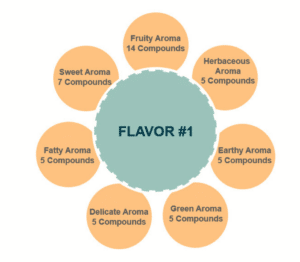
Aroma Analysis
Customer A would like to understand the aroma of a palatant to differentiate it from other flavors. The electronic nose can identify and generate a signature aroma profile of a palatant based on the compounds present to categorize them into various classes.
Product Performance
The combination of e-nose and e-tongue is utilized to understand the relative differences in smell and taste between the products. The plot shown below is known as a Principal Component Analysis (PCA) which explains the degree of separation in both x and y axis between the products. The bigger the number in either x or y axis, the higher is the degree of difference. This helps our customers understand the relative similarities or differences that could potentially distinguish them in the market place.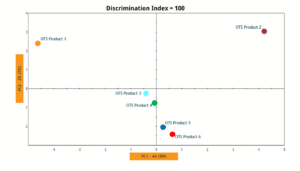
Product Stability and Shelf life
Customer C wants to understand how their kibble is changing over time. At specific time intervals the kibble is evaluated on the e-nose and compared to previous samples of the same kibble. The chromatogram shows that over time the kibble is changing. In this example, the intensity and abundance of the compounds in the kibble are increasing. This could affect the aroma of the kibble over time.
Flavor Profile Analysis
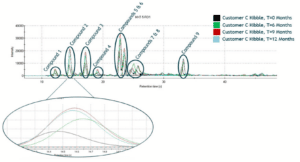
The Electronic Tongue provides us with a flavor profile of a product. A flavor profile shows the intensity of five different tastes; sour, salty, umami, sweet and bitter on a scale of 0-12. The figure below shows the flavor profile of eight different products with various intensities. This information provides directional insights to our scientist to design their Design of Experiment (DOE) hypothesis.
Off-Odor Analysis
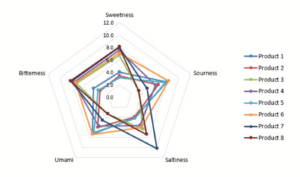
Customers sometimes approach us with issues related to off-odor. The example below is a raw material with an off-odor which was analyzed using the e-nose. The aroma profile shows various compounds that could possibly lead to an off-odor. Comparing the profile of this raw material with our in-house aroma database, we were able to identify the combination of aldehydes and dimethyl disulfide as the source of the off-odor.
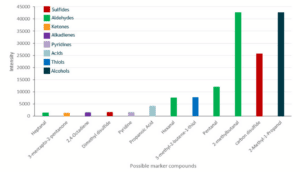
For more details on potential applications with your pet food, contact your sales representative or visit https://www.afbinternational.com/contact/